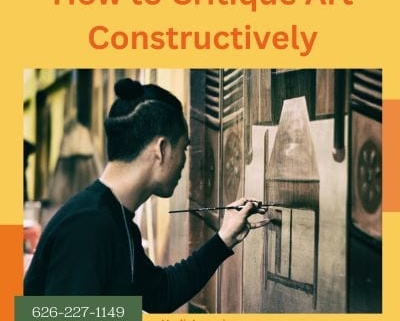How to Critique Art Constructively
Art is deeply personal; often times the work we create is a reflection of who we are and what we’ve experienced. Because of how personal art is, receiving criticism can be an emotional experience. However, constructive critique can be an invaluable tool for growth. Whether you’re critiquing someone else’s work or receiving feedback on your own, it’s important to approach the process with respect, curiosity, and the shared goal of improvement.
Here’s how to critique art respectfully in order to foster a supportive and creative learning environment.
Start With the Positive
When offering feedback, begin with what you appreciate about the artwork. Acknowledging the strengths of a piece first creates a positive foundation for the conversation. It lets the artist know you’ve seen and appreciate their work. Compliment the artist’s technique, use of color, composition, or even the emotions the piece evokes. These compliments help build confidence and help the artist to feel more open to constructive suggestions.
Example: “I love how the color palette creates a calming atmosphere, and the texture really draws me in.”
Be Specific and Actionable
Vague feedback can be frustrating and unhelpful. Instead of saying something broad like “It’s not working for me,” point to specific areas and suggest ways the artist can improve. Constructive criticism is most effective when it’s tied to something actionable.
Example: “The main focus of the image is great, but the lack of detail in the foreground feels a bit flat. Maybe playing with the depth of field to bring more texture to the rocks or foliage could add more dimension to the overall composition.”
Consider the Artist’s Intent
Before critiquing, take time to understand the artist’s goals and intentions with the piece. Ask questions like, “What message were you trying to convey?” or “Is there a specific technique you’re exploring?” Aligning your feedback with their artistic vision shows respect and can help them refine their ideas without derailing their creative process.
Example: “Since you mentioned wanting the figure to appear as if it’s reaching forward in a moment of action, one thing that could help strengthen that effect is adjusting the angle of the upper body.”
Stay Constructive and Respectful
Constructive criticism means offering insights that help improve the work, not diminish the artist’s confidence. Avoid using harsh or dismissive language that can be discouraging. Frame your feedback as suggestions rather than demands, and always maintain a respectful tone.
Example: “I think adding more variation to the brushstrokes could enhance the movement in this section. What do you think?”
Encourage Experimentation
Art is about exploration, and sometimes experimentation leads to breakthroughs. Encourage the artist to take risks, even if it means their piece isn’t perfect. Growth often happens when an artist steps out of their comfort zone.
Example: “It’s great that you experimented with different textures here. What would happen if you pushed this even further in your next piece?”
How to Receive Criticism Constructively
Being on the receiving end of critique can be challenging, but by keeping an open mind, you can experience personal and artistic growth.
1. Listen Without Defending
It can be tempting to explain your choices or defend your work, but try to listen fully before responding. Understand the perspective of the person giving the critique and consider how their feedback might enhance your work.
2. Ask for Clarification
If the feedback is unclear, don’t be afraid to ask for more details. Understanding the specifics of what someone is pointing out can help you apply the critique more effectively.
3. Reflect and Decide
Not all feedback will resonate with you, and that’s okay. After receiving a critique, take time to reflect. Decide which suggestions align with your goals and vision, and discard the ones that don’t.
Conclusion
Learning how to give and receive critiques is an essential part of artistic development. By embracing a constructive and supportive approach, both students and artists can improve their craft, deepen their understanding, and continue to push creative boundaries. If you’re looking to further enhance your skills and be part of a nurturing art community, our one-on-one art lessons provide personalized guidance tailored to your needs. Call us or submit a form to get started today.



